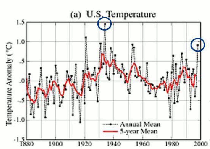My advice: ignore all the surface temperature records full stop. GISS (administered by warmist activist James Hansen), HadCRUT (Phil “Climategate” Jones), they’re all as bad as each other – “homogenised” to within an inch of their lives. So it comes as little surprise that the latest version of the Hadley/CRU temperature database now shows 2010 as being warmer than 1998. How convenient.
And isn’t it amazing that it now better fits the global warming narrative? Just like GISS – it was inconvenient that the 1930s were warmer in that dataset than the present, but never mind, they found a way round it (click the image) – magic!
And oddly, despite massive urbanisation in the 20th century, many of the adjustments make earlier years COOLER, the opposite of what would be expected in order to compensate for modern UHI.
If you torture the data enough, they will surely confess:
Researchers have updated HadCRUT – one of the main global temperate records, which dates back to 1850.
One of the main changes is the inclusion of more data from the Arctic region, which has experienced one of the greatest levels of warming.
The amendments do not change the long-term trend, but the data now lists 2010, rather than 1998, as the warmest year on record.
The update is reported in the published in the Journal of Geophysical Research.
HadCRUT is compiled by the UK Met Office’s Hadley Centre and the Climatic Research Unit (Cru) at the University of East Anglia, and is one of three global records used extensively by climatologists.
The other two are produced by US-based researchers at Nasa and the National Oceanic and Atmospheric Administration (Noaa).
Cru’s director, Phil Jones, explained why it was necessary to revise the UK record.
“HadCRUT is underpinned by observations and we’ve previously been clear it may not be fully capturing changes in the Arctic because we have had so little data from the area,” he said.
“For the latest version, we have included observations from more than 400 (observation) stations across the Arctic, Russia and Canada.”
Prof Jones added: “This has led to better representation of what’s going on in the large geographical region.”
Despite the revisions, the overall warming signal has not changed. The scientists say it has remained at about 0.75C (1.4F) since 1900. (BBC)
Oh well, I guess there’s only so much you can do in one hit, but give it time.
Much more at WUWT.



Recent Comments